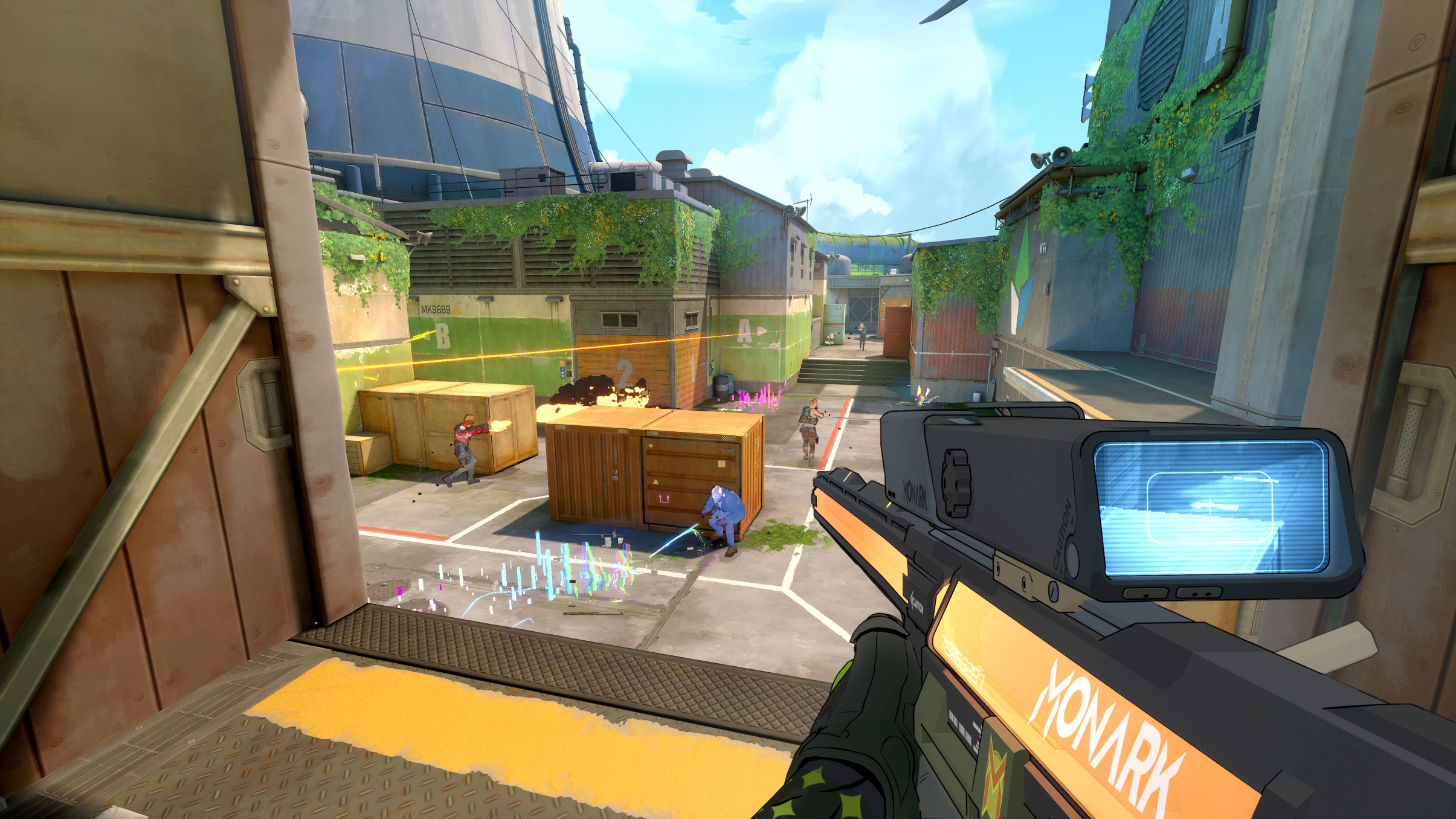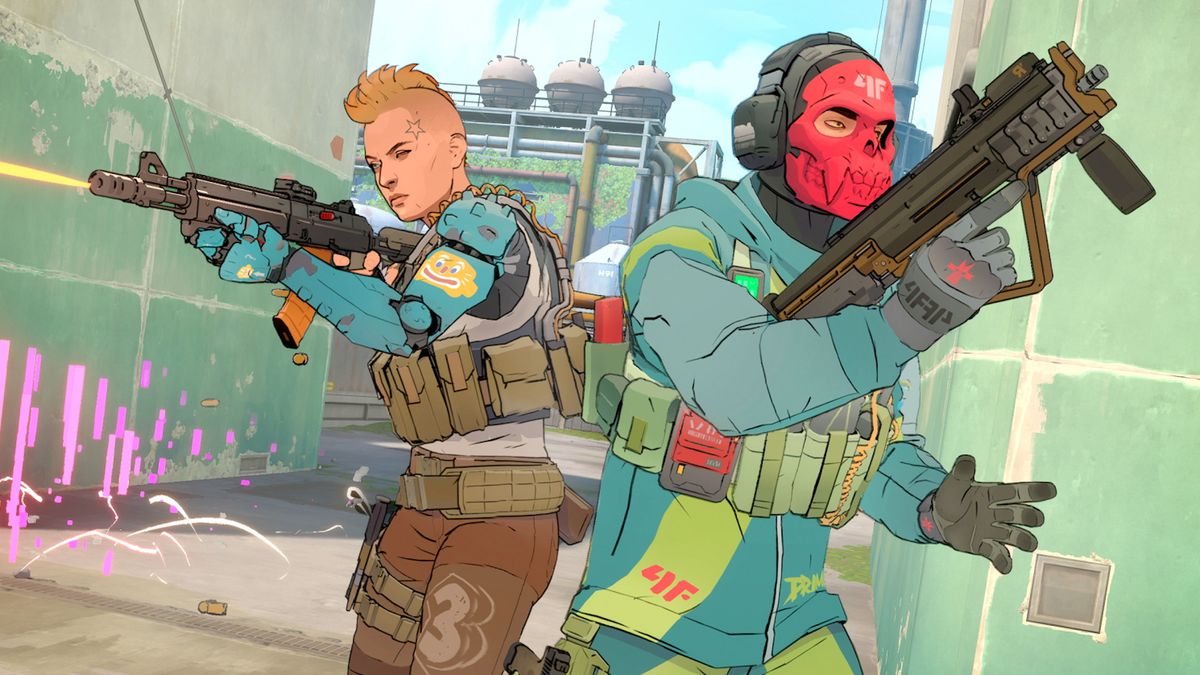Do you ever wonder why there aren’t many tactical shooters like Counter-Strike? Valve’s round-based, economy-driven competitive FPS stood largely unchallenged in a subgenre it created for 20 years before Valorant arrived on the scene, painting over CS:GO’s grounded arsenal with a roster of Riot-style heroes and playmaking ultimate moves. Valorant was exciting proof that there’s more to be done with the CS formula, and more than enough player interest to support two tac shooter giants.
Spectre Divide wants to be the third. After playing a few matches, I think it has a decent shot.
I know, I’m still on the fence about the name too, but I’ll keep saying it out loud until it sounds normal. Spectre Divide is the debut game from Mountaintop Studios, an independent startup with an 80-person team boasting veteran talent from Respawn, Riot, Bungie, Blizzard, and Valve.
I went into a Spectre preview session last week anticipating I wouldn’t have much to say. Despite a brief love affair with Valorant at launch and 70-ish hours of CS:GO, I’ve never managed to embrace their strict stop-and-pop gunplay. Spectre has a buy menu, econ rounds, bomb sites, Shift walking, knife running, and a one-shot-kill sniper rifle just like you’d expect, but its shooting is more accessible with bullets that always go where you’re aiming. That alone is a huge change to how these games are traditionally played, but it’s actually one of two tweaks to CS/Valorant that Mountaintop considers “core pillars” of Spectre:
- Teams are 3v3, but everyone controls two bodies: Literally. You spawn in your first body and can switch to your second body at any time, wherever they are on the map. Mountaintop calls the mechanic “Duality,” and your clone is your “spectre”. If you’re a Phoenix main in Valorant, this is “Run it Back” the game.
- ADS is king: Spectre is an aim-down-sights dominant FPS. Recoil patterns can be learned and mastered, but your dot sight will always represent where bullets are traveling (think Rainbow Six Siege).

Double take
The whole Duality thing is as strange as it sounds. You can body swap at any time, but you can also toss a puck to move your other body to a new location. Mountaintop showed us an overview trailer that explained how the spectre is meant to be used: you can watch two angles at once, cover your own flank, or use one body to make a distraction at bombsite A then switch to your other body at bombsite B.
According to game director Lee Horn, who previously worked on Apex Legends and Valorant, the Duality mechanic was initially created to solve a problem. Inspired by the small team formats of shooters like Apex, Destiny, and classic Halo Team Doubles, Mountaintop knew early on that it wanted its shooter to be 3v3.
“It has a lot of social benefits, right?” Horn told PC Gamer. “It’s easier to find two buddies to play with, it’s way easier to communicate a lot cleaner, you contribute more, all of those things really matter.”
But the team struggled to adapt smaller teams to a traditional attack/defense bomb mode. Teams were spread too thin.
“What happens is, when you have one defender on each site, imagine three attackers rushing that defender, eliminating them—the space is kind of solved. We have the site, take it over. That game is still fun, but it’s not 10,000 hours fun.” Then one night, the idea hit him: “What if I could be in two spots at once? That would solve the problem.”
With two bodies, “attackers can’t just rush anymore,” and Mountaintop can still preserve the tight-knit qualities of 3v3. As an added bonus, players spend a lot more time actually playing.
Still, Duality is confusing at first. Jumping headfirst into a map I’ve never seen with guns I’ve never used was enough to worry about without a second body to keep track of, but Horn, who was serving as team captain, gave me a simple tip: stash my second body somewhere safe, then don’t worry about it until I need it. In that way, Duality can simply be used as a second chance at every round. If I strolled into the site, forgot to check the right flank and got shot in the head, I was zipped to my backup body in less than a second. If you’ve sunk 1,000 hours into one of these games and ever felt like you spent most of that time staring at a spectate screen, you can imagine how empowering it feels to make a mistake and get an instant chance to redeem yourself.
By our second match, without anybody really acknowledging it, we started taking bigger risks with our spectres.
That more-or-less describes how my first Spectre match played out. We’d push, get a kill or two, die, then try to mount a comeback with our backups. By our second match, without anybody really acknowledging it, we started taking bigger risks with our spectres—splitting our bodies between two sites, aggressively tossing pucks behind enemy lines, daring to swap bodies mid-firefight to repeek an angle.
I even did something I never felt confident enough to pull off in Counter-Strike: immediately peaking mid with a sniper rifle. In one high point of my demo, I peeked a corner, killed two but died, then used that information to immediately watch that position from a longer angle with my spectre and wipe the rest of the team with a heavy machine gun. Moments like that graduated Duality from “maybe just a gimmick” to “actually, this is pretty sweet.”
The highs helped soften some pretty spectacular blunders, too. Several times I tried to throw a smoke grenade but accidentally tossed my spectre puck instead, offering up my backup life as an unholy sacrifice to the other team. At one point, our team was on a three-round winning streak and I tried to get fancy by body swapping while I was planting the bomb (a tactic Spectre supports), but I messed up the inputs and ended up lining up an easy double kill for the last enemy on the team. That’s when I discovered another hidden benefit of 3v3: four fewer people watching your worst screw ups live in HD.

Skill issue
Body swapping is Mountaintop’s flashiest feature, but Spectre’s gunplay is arguably its biggest break in tradition. Every Spectre gun has aim-down-sights, and with the exception of sniper rifles, you can move and shoot without losing accuracy.
It’s hard to overstate how much of a difference this makes—learning to come to a complete stop in Counter-Strike before firing a shot is a skill unique to this specific type of game. Leaving it behind risks alienating tac shooter lifers who’ve been shooting from the hip for 20 years, but Mountaintop believes it’ll also attract a new faction of FPS fans who’ve never jived with CS.
You’re still mastering recoil patterns, but they’re more immediately understandable. You don’t have to go research the pattern, you just shoot the wall, watch your crosshair.
Lee Horn, game director
“We’re super excited about true-to-crosshair ADS unlocking tac shooters for a whole group of people for whom [Counter-Strike’s] shooting model is not the right thing for them,” Horn said. “Hopefully we’ve given them that.”
But Horn points out one aspect of Spectre’s guns that should feel familiar to the tac shooter senior class is recoil patterns—they’re deterministic, meaning they can be studied and mastered. There is some random spread when hipfiring, a tactic that Horn only recommends in very close-quarters scenarios.
“At the end of the day, you’re still mastering recoil patterns, but they’re more immediately understandable. You don’t have to go research the pattern, you just shoot the wall, watch your crosshair.”
I might just be one of those potential converts. Spectre’s shooting was immediately comfortable and right to me in a way I’ve never felt in CS. Browsing the buy menu was like pacing the aisles of a candy store. I wanted to try everything, and I liked almost all of it. But I don’t think traditional ADS will mean everyone can easily pop headshots like they do in Rainbow Six Siege. The recoil on SMGs and lower-tier assault rifles are still a handful—I’m just better equipped to deal with them. I do wonder what sort of unexpected affects Spectre’s gunplay and Duality will have on this sort of game. Will teams struggle to take rounds slowly when they always have a backup life?

Utility
I’ll draw a circle around one more major aspect of Spectre: Sponsor kits. These are essentially classes that come with unique utility. I noticed a lot of Valorant in these kits—varieties of smoke grenades, vision-blocking walls, and proximity mines all stylized around a fictional corporate sponsor in the world of Spectre—but they’re noticeably toned down. Utility isn’t meant to be the star of the show.
“There are no over-the-top ultimates to act as an insta-win button,” Horn says in an overview video. “Skill reigns supreme.”
But Spectre’s kits are still louder than Counter-Strike’s grounded utility belt. One class has a self-heal that replenishes both of your bodies at once, and also grants a speed boost to the user’s spectre. There’s a scanning dart that’s extremely close to Sova’s recon arrow in Valorant and a smoke grenade that can automatically teleport your spectre wherever it lands.
Other notable details
- Matches are shorter than CS2 and Valorant: 7-round halves
- Guns are bought in pairs: One “specialist” weapon for your first body, and an “anchor weapon” for your spectre
- You can split the cost of guns with teammates
- Guns can be dropped, picked up, and saved, meaning you can end up with two AWPs on one player
- Free-to-play, gun skins, battle passes, the works: Mountaintop says all of its skin upgrades can be grinded
I take it as a good sign when I’m several days removed from playing a multiplayer shooter and can’t stop thinking about when I’ll get to play it next. Today represents Mountaintop’s official debut of Spectre, but Horn tells me they’ve actually held closed testing for over a year now. The Steam page for Spectre is live now, where you can also request access to the next playtest.











